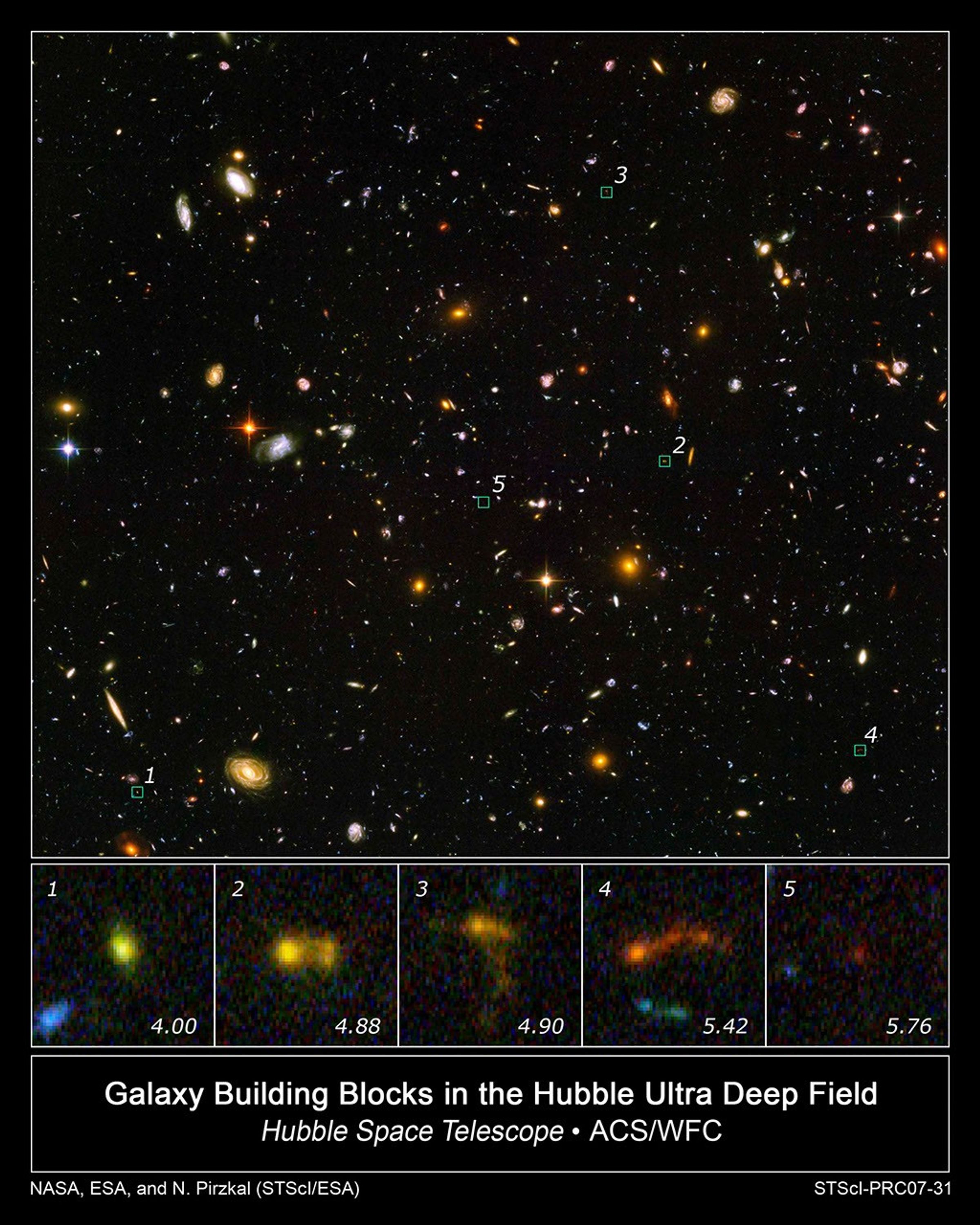1 min read
Hubble Building Blocks Galaxy at Redshift 5.76

Building block galaxy at redshift of 5.76 from Hubble Ultra Deep Field image.
About the Object
- ConstellationConstellationOne of 88 recognized regions of the celestial sphere in which the object appears.Fornax
- DistanceDistanceThe physical distance from Earth to the astronomical object. Distances within our solar system are usually measured in Astronomical Units (AU). Distances between stars are usually measured in light-years. Interstellar distances can also be measured in parsecs.Redshift: 5.76
About the Data
- Data DescriptionData DescriptionProposal: A description of the observations, their scientific justification, and the links to the data available in the science archive.
Science Team: The astronomers who planned the observations and analyzed the data. "PI" refers to the Principal Investigator.GRAPES HST Data The science data were selected based on findings from The Grism-ACS Program for Extragalactic Science (GRAPES), HST proposal 9793: S. Malhotra et. al. The science team includes: N. Pirzkal (STSCI/ESA) S. Malhotra and J. Rhoads (Arizona State University), and C. Xu (Shanghai Institute of Technical Physics). HUDF HST Data This image of the HUDF was created from HST data from the following proposal: 9978: S. Beckwith, S. Malhotra, M. Giavalisco, N. Panagia, J. Rhoads, M. Stiavelli, R. Somerville, S. Casertano, B. Margon, C. Blades, J. Caldwell, and M. Clampin (STScI), M. Corbin (STScI/CSC), M. Dickinson, H. Ferguson, and A. Fruchter (STScI), R. Hook (STScI/ECF), S. Jogee, A. Koekemoer, R. Lucas, M. Sosey, and L. Bergeron (STScI). NICMOS HUDF Data The NICMOS HUDF data were from proposal 9803: R. Thompson (University of Arizona), G. Illingworth and R. Bouwens (university of California, Santa Cruz), M. Dickinson (STScI), D. Eisenstein and X. Fan (University of Arizona), M. Franx (University of Leiden), M. Rieke (University of Arizona), A. Riess (STScI), and P. van Dokkum (Yale University). The Spitzer science team includes: H. Yan (Caltech), M Dickinson (NOAO), D. Stern and P. Eisenhardt (Jet Propulsion Lab), R.-R. Chary (Caltech), M. Giavalisco (STScI), H. Ferguson and S. Casertano (STScI), C. Conselice (Caltech), C. Papovich (Steward Observatory), W. Reach (Caltech), N. Grogin (STScI), L. Moustakas (Jet Propulsion Lab), and M. Ouchi (STScI). - InstrumentInstrumentThe science instrument used to produce the data.HST>ACS/WFC, HST>ACS/NICMOS, and SST>IRAC
- Exposure DatesExposure DatesThe date(s) that the telescope made its observations and the total exposure time.September 24, 2003 - January 16, 2004, Exposure Time: 11.3 days (ACS/WFC), September 3, 2003 - November 27, 2003, Exposure Time: 11.3 days (ACS/NICMOS), and February 2004, Exposure Time: 5 days (IRAC)
- FiltersFiltersThe camera filters that were used in the science observations.ACS/WFC: F435W (B), F606W (V), F775W (i), F850LP (z) ACS/NICMOS: F110W (J110) and F160W (H160) IRAC: 3.6, 4.5, 5.8, and 8.0 microns
- Object NameObject NameA name or catalog number that astronomers use to identify an astronomical object.Galaxy in the Hubble Ultra Deep Field (HUDF)
- Object DescriptionObject DescriptionThe type of astronomical object.Distant galaxy in the HUDF
- Release DateSeptember 6, 2007
- Science ReleaseHubble and Spitzer Space Telescopes Find “Lego-Block” Galaxies in Early Universe
- Credit

Color Info
Color InfoA brief description of the methods used to convert telescope data into the color image being presented.
Blue: F435W (B) Green: F606W (V) + F775W (i) Red: F850LP (z)

Compass and Scale
Compass and ScaleAn astronomical image with a scale that shows how large an object is on the sky, a compass that shows how the object is oriented on the sky, and the filters with which the image was made.
Related Images & Videos

Hubble and Spitzer Uncover Smallest Galaxy Building Blocks
In this image of the Hubble Ultra Deep Field, several objects are identified as the faintest, most compact galaxies ever observed in the distant universe. They are so far away that we see them as they looked less than one billion years after the Big Bang. Blazing with the...
Share
Details
Last Updated
Aug 17, 2025
Contact
Media
Claire Andreoli
NASA’s Goddard Space Flight Center
Greenbelt, Maryland
claire.andreoli@nasa.gov

































